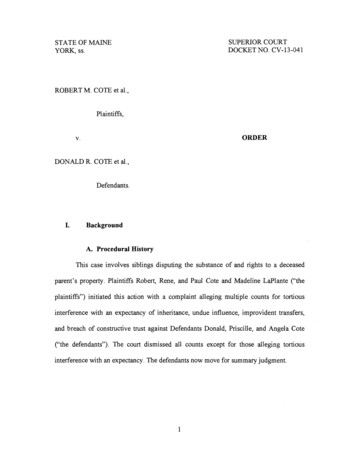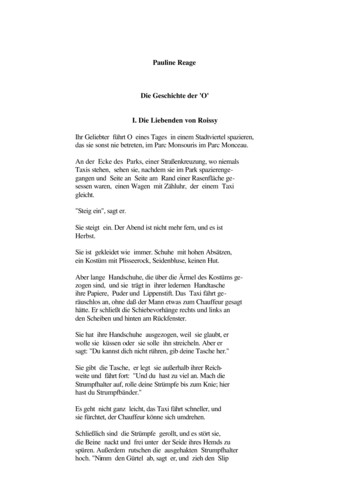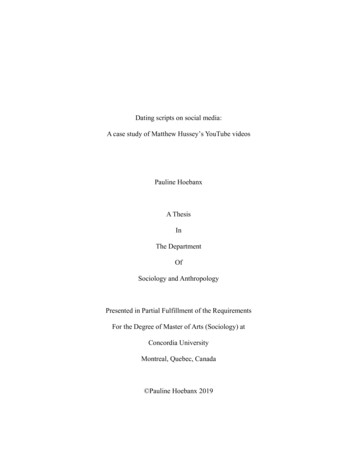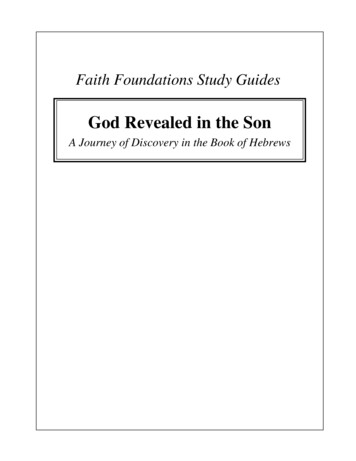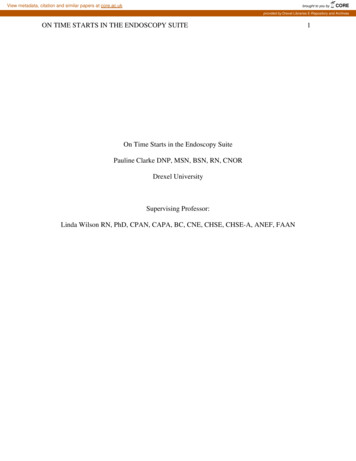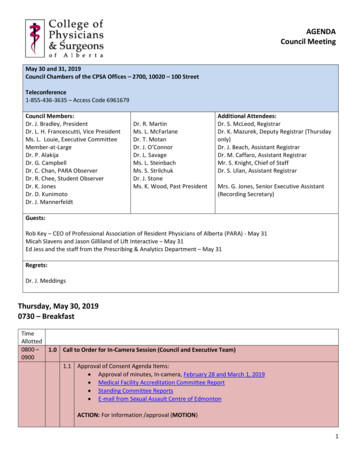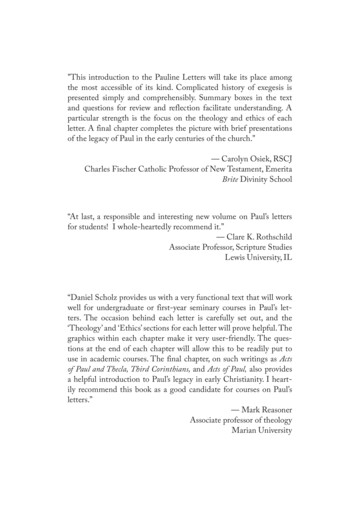
Transcription
"This introduction to the Pauline Letters will take its place amongthe most accessible of its kind. Complicated history of exegesis ispresented simply and comprehensibly. Summary boxes in the textand questions for review and reflection facilitate understanding. Aparticular strength is the focus on the theology and ethics of eachletter. A final chapter completes the picture with brief presentationsof the legacy of Paul in the early centuries of the church."— Carolyn Osiek, RSCJCharles Fischer Catholic Professor of New Testament, EmeritaBrite Divinity School“At last, a responsible and interesting new volume on Paul’s lettersfor students! I whole-heartedly recommend it.”— Clare K. RothschildAssociate Professor, Scripture StudiesLewis University, IL“Daniel Scholz provides us with a very functional text that will workwell for undergraduate or first-year seminary courses in Paul’s letters. The occasion behind each letter is carefully set out, and the‘Theology’ and ‘Ethics’ sections for each letter will prove helpful. Thegraphics within each chapter make it very user-friendly. The questions at the end of each chapter will allow this to be readily put touse in academic courses. The final chapter, on such writings as Actsof Paul and Thecla, Third Corinthians, and Acts of Paul, also providesa helpful introduction to Paul’s legacy in early Christianity. I heartily recommend this book as a good candidate for courses on Paul’sletters.”— Mark ReasonerAssociate professor of theologyMarian University7044 PaulineLetters Pgs.indd 12/27/2013 8:37:58 AM
Author AcknowledgmentsI offer my sincere thanks and gratitude to Kathleen Walsh andMaura Hagarty at Anselm Academic, and especially to Jim Kelhoffer, for their enormous editorial contributions that brought this bookto completion. Most importantly, I thank my wife, Bonnie, and ourthree children, Raymond, Andrew, and Danielle, for their patienceand support throughout this writing project.Publisher AcknowledgmentsThe publisher owes a special debt of gratitude to James A. Kelhoffer,PhD, who advised throughout this project. Dr. Kelhoffer’s expertiseand passion both as teacher and scholar contributed immeasurablyto this work. Dr. Kelhoffer holds a PhD in New Testament andEarly Christian Literature from the University of Chicago and isprofessor of Old and New Testament Exegesis at Uppsala Universityin Sweden.The publisher also wishes to thank the following individual whoreviewed this work in progress:Jeffrey S. SikerLoyola Marymount University, Los Angeles, California7044 PaulineLetters Pgs.indd 22/27/2013 8:38:11 AM
Introducing the New TestamentDaniel J. ScholzJames A. Kelhoffer, Academic Editor7044 PaulineLetters Pgs.indd 32/27/2013 8:38:21 AM
Created by the publishing team of Anselm Academic.Cover art: Lorrain, Claude (Gellee) (1600–1682). The Embarkation of St. Paul of Rome atOstia. Museo del Prado, Madrid, Spain. Scala / Art Resource, NYThe scriptural quotations in this book are from the New American Bible, revised edition 2010, 1991, 1986, and 1970 by the Confraternity of Christian Doctrine, Inc.,Washington, DC. Used by permission of the copyright owner. All rights reserved. Nopart of this work may be reproduced in any form without permission in writing fromthe copyright owner.Copyright 2013 by Daniel J. Scholz. All rights reserved. No part of this book maybe reproduced by any means without the written permission of the publisher, AnselmAcademic, Christian Brothers Publications, 702 Terrace Heights, Winona, MN55987-1320, www.anselmacademic.orgPrinted in the United States of America7044ISBN 978-1-59982-099-67044 PaulineLetters Pgs.indd 42/27/2013 8:38:21 AM
ContentsIntroduction: Studying Paul and His Letters9PART 1: The Undisputed Pauline Letters1. Paul of Tarsus17Introduction / 17Understanding and Interpreting Paul / 19The Life and Letters of Paul / 352. First Thessalonians56Introduction / 56Historical Context of 1 Thessalonians / 57Theology and Ethics of 1 Thessalonians / 683. First Corinthians79Introduction / 79Historical Context of 1 Corinthians / 81Theology and Ethics of 1 Corinthians / 924. Second Corinthians108Introduction / 108Historical Context of 2 Corinthians / 109Theology and Ethics of 2 Corinthians / 1207044 PaulineLetters Pgs.indd 52/27/2013 8:38:21 AM
5. Galatians131Introduction / 131Historical Context of Galatians / 132Theology and Ethics of Galatians / 1426. Romans156Introduction / 156Historical Context of Romans / 157Theology and Ethics of Romans / 1687. Philippians181Introduction / 181Historical Context of Philippians / 183Theology and Ethics of Philippians / 1958. Philemon205Introduction / 205Historical Context of Philemon / 206Theology and Ethics of Philemon / 215PART 2: The Disputed Lettersand Post-Pauline Writings9. Colossians, Ephesians,and Second Thessalonians225Introduction / 225Historical Context of Colossians, Ephesians,and 2 Thessalonians / 227Theology and Ethics of Colossians, Ephesians,and 2 Thessalonians / 24310. First Timothy, Second Timothy, and Titus255Introduction / 255Historical Context of the Pastoral Letters / 256Theology and Ethics of the Pastoral Letters / 2697044 PaulineLetters Pgs.indd 62/27/2013 8:38:21 AM
11. Later Letters, Narratives,and the Apocalypse of Paul279Introduction / 279The Continuing Legacy of Paul / 280Overview of the Later Letters, Narratives,and the Apocalypse of Paul / 292Index7044 PaulineLetters Pgs.indd 73032/27/2013 8:38:21 AM
7044 PaulineLetters Pgs.indd 82/27/2013 8:38:21 AM
IntroductionStudying Pauland His LettersNext to Jesus, no figure has had more influence in Christian tradition and history than Paul. In fact, studying Paul’s letters is essentialfor understanding Christianity. Fortunately, the Christian Scripturesprovide plenty of source material to understand and interpret Paul.Just as the four Gospels of Matthew, Mark, Luke, and John informreaders about Jesus, the thirteen Pauline letters in the New Testamentprovide information about Paul and his followers. In addition to theseletters, the New Testament Acts of the Apostles also focus on Paul inits narrative of the early church’s mission and development. Outsidethe Christian Scriptures, other letters and narratives contribute tounderstanding Paul and his impact in Christian tradition and history.One of the most important and surprising features of the thirteen New Testament letters attributed to Paul is that some of theseletters most likely do not come directly from Paul. Of the thirteenPauline letters, scholars are convinced that seven are “undisputedletters” of Paul. The seven undisputed Pauline letters are Romans,1 Corinthians, 2 Corinthians, Galatians, Philippians, 1 Thessalonians, and Philemon. Written between 50 and 60 CE, these lettersprovide direct access to Paul and offer insights into the world of thefirst Christians. These seven letters are the primary sources usedtoday to understand and interpret Paul.The six others Pauline letters fall into the category of the“deutero-Pauline letters”: Colossians, Ephesians, 2 Thessalonians,1 Timothy, 2 Timothy, and Titus. Deutero- is a Greek prefix meaning, “second” or “secondary.” These six letters are widely regarded byscholars as written by followers of Paul sometime between 70 and97044 PaulineLetters Pgs.indd 92/27/2013 8:38:21 AM
10 T h e P a u l i n e L e t t e r s120 CE. For this reason, these letters are often referred to as the“disputed letters” of Paul.The Letters of Paul in the New TestamentIn the New Testament, the thirteen letters attributed to Paul followthe four Gospels of Matthew, Mark, Luke, and John and the Acts ofthe Apostles.The Pauline letters appear in the Bible not in chronologicalorder but according to length of these letters. Thus, Romans, thelongest of the letters with 7,111 words and 1,687 total verses,comes first. Philemon, with 335 words and only 25 verses, appearslast in the Bible.BookAbbreviationRomansRom1 Corinthians1 Cor2 Corinthians2 nsCol1 Thessalonians1 Thess2 Thessalonians2 Thess1 Timothy1 Tim2 Timothy2 TimTitusTiPhilemonPhlmThe Acts of the Apostles is another important source for understanding Paul. Written a generation or two after Paul by the sameauthor who wrote the Gospel of Luke, Acts narrates events fromthe ascension of Jesus in Jerusalem to the imprisonment of Paul inRome. The author, Luke, commits the entire second half of Acts7044 PaulineLetters Pgs.indd 102/27/2013 8:38:21 AM
Introduction: Studying Paul and His Letters11to the missionary activities of Paul. Some of what is known aboutPaul from his authentic letters is supported by details from Acts. Forexample, the presence of Sosthenes and Crispus in Corinth in Acts18 parallels references in 1 Corinthians to Sosthenes (1:1) and Crispus (1:14). Other times, however, details from Paul and Acts contradict. For instance, in Galatians 1:18, Paul explains that he waitedthree years after his call to go to Jerusalem. However, in Acts 9, Paul’svisit to Jerusalem appears to occur much more quickly. Needless tosay, these types of disagreements have led scholars to question thehistorical reliability of Acts. Given this, most scholars consider Actsas a secondary source for understanding Paul, as its presentation ofPaul is shaped by Luke’s theology and cannot consistently be crossreferenced with information from Paul’s letters.New Testament Sources on PaulUndisputed Pauline Letters: 50–60 CERomans1 Corinthians2 CorinthiansGalatiansPhilippians1 ThessaloniansPhilemonDeutero-Pauline Letters: 70–120 CEColossiansEphesians2 Thessalonians1 Timothy2 TimothyTitusNarrative: 85–90 CEActs of the Apostles7044 PaulineLetters Pgs.indd 112/27/2013 8:38:21 AM
12 T h e P a u l i n e L e t t e r sThe remaining sources that help us to understand and interpretPaul fall into the category of extracanonical sources; that is, earlysource material not included in the canon of the Christian Scriptures. This source material is classified according to its literary form:letters, narratives, or apocalypses (end of the age stories). Writtenmostly in the second and third centuries CE, these sources highlightthe legacy of Paul centuries after his death.Extracanonical Sources on PaulNarrative: 180–200 CEActs of Paul (including Acts of Paul and Thecla)Letters: 150–300s CE3 CorinthiansEpistle to the LaodiceansCorrespondence of Paul and SenecaApocalypse: 250 CEApocalypse of PaulThe New Testament sources reveal three important insightsinto Paul. First, Paul is complicated. Whether in his early years as aJewish Pharisee who was a leader of the persecution of the originalChristians or in his later years, when he challenged Jewish Christians to accept uncircumcised Gentile Christians as partners in faith,Paul was no stranger to facing controversy. Further, Paul’s theological thinking, as seen in the letters, presents a remarkable integrationof Jewish theology and Greek thought that is not easily understoodtoday. Second, Paul had an enormous task to accomplish in proclaiming Jesus Christ to the Gentiles. In Paul’s own words, he interpretedhis encounter with the resurrected Christ as a call from God to “proclaim [ Jesus] to the Gentiles” (Gal 1:16). In response to this call,Paul spent the next thirty years spreading the “good news” of JesusChrist to Gentiles living in the eastern half of the Roman Empire.7044 PaulineLetters Pgs.indd 122/27/2013 8:38:21 AM
Introduction: Studying Paul and His Letters13Third, Paul’s theology eventually influenced the course of Christianhistory and theology. Within Paul’s lifetime, there were competingideas and beliefs about Jesus. Paul’s voice was one among many.Despite the availability of the various New Testament andextracanonical sources, Paul remains elusive. However, with the riseof various scientific methods for studying the sources in the past twohundred years, theologians and scholars have learned much abouthow to better understand and interpret Paul and his letters. ThePauline Letters presents the fruits of this labor and addresses someof the context and background information needed for an informedunderstanding of Paul and his letters.Chapter 1, “Paul of Tarsus,” begins with a brief history of themodern interpretation of Paul. This chapter includes the criteria andsources used in this book for interpreting Paul as well as the firstcentury Jewish and Hellenistic contexts on him. The second half ofthe chapter summarizes what scholars know about the life of Pauland presents an overview of his letters and of ancient letter writing.Chapter 1 lays the foundation for the two main parts of thisbook—part 1: the seven undisputed Pauline letters, and part 2: thedisputed letters and post-Pauline writings. Part 1 consists of chapters 2–8 and takes up the seven undisputed letters of Paul. Althoughscholars debate about the dates and order of composition of the letters, part 1 of this book proceeds with the following hypotheticaldates and order:1 Thessalonians50 CE1 CorinthiansSpring 55 CE2 CorinthiansFall 55 CEGalatiansLate 55 CERomansSpring 56 CEPhilippians60 CEPhilemonLate 60 CEThese chapters focus on the historical, social, and literary contexts of each letter as well as what these letters reveal about Paul’stheology and ethics.7044 PaulineLetters Pgs.indd 132/27/2013 8:38:21 AM
14 T h e P a u l i n e L e t t e r sPart 2 begins by examining the six remaining letters attributed to Paul—but disputed by scholars—in the New Testament.Although scholars debate the dates and order of composition ofthese letters also, part 2 of this book proceeds with the followinghypothetical dates:Colossians70–100 CEEphesians80–110 CE2 Thessalonians90–100 CE1 Timothy100 CE2 Timothy100 CETitus100 CEChapter 9 focuses on the deutero-Pauline (or disputed) lettersof Colossians, Ephesians, and 2 Thessalonians; and chapter 10 considers the disputed letters of 1 Timothy, 2 Timothy, and Titus, alsoknown as the Pastoral Letters. These chapters discuss the developing historical, social, and literary contexts in which the letters werewritten as well as the theology and ethics of each letter. Chapter 11provides a historical and theological overview of certain later letters,narratives, and an apocalypse that claim to convey traditions aboutPaul. Knowledge of these extracanonical sources is important forunderstanding the legacy of Paul in the second and third centuries.Studying Paul and his letters will provide readers with muchinformation and plenty of insights into Paul. The abundance ofsources on Paul, canonical and extracanonical, will shed light onthe obstacles and opportunities that the earliest Christians faced inspreading their versions of the good news of Jesus Christ throughoutthe Roman Empire.7044 PaulineLetters Pgs.indd 142/27/2013 8:38:21 AM
Part 1The UndisputedPauline Letters7044 PaulineLetters Pgs.indd 152/27/2013 8:38:21 AM
7044 PaulineLetters Pgs.indd 162/27/2013 8:38:21 AM
c h ap t e r 1Paul of TarsusI nt r od u c t i o nThis chapter examines the historical figure of Paul of Tarsus. Thebeginning of the chapter includes a brief survey of modern attemptsto interpret Paul as well as the interpretative criteria to be used inthis book. It also includes some details of the canonical and extracanonical sources available for understanding Paul as well as thefirst-century Jewish and Hellenistic influences that shaped his lifeand work. The latter part presents a summary overview of Paul’s lifeand some background information on his letters.The Reception of Paulin Christian History and TheologyThe reception of Paul and his letters in the formation of the NewTestament and throughout Christian history can hardly be overstated. Nearly half of the New Testament writings are attributedto him: thirteen of the twenty-seven books of the New Testamentare traditionally associated with Paul, and his legacy stretches wellbeyond them. Leading figures from every period of church historyhave wrestled with the person of Paul and his theological thinking.From the writings of church fathers (such as Augustine of Hippo)to the theology of the sixteenth-century Reformers (such as MartinLuther) to the rise of the modern historical criticism (for example,F. C. Baur and Ernst Troeltsch) and the “new perspective” on Paul(such as E. P. Sanders), scholars have responded to the theology andperson of Paul as reflected in his surviving letters.177044 PaulineLetters Pgs.indd 172/27/2013 8:38:21 AM
18 T h e P a u l i n e L e t t e r sA Biblical Figure like No OtherUnlike any other figure in the New Testament, Paul can be known ina unique and distinctive way—through the seven letters that scholars are confident he wrote. Within the context of modern historicalcriticism of the Bible, such a claim can be said of no one else in theNew Testament, including Jesus. To be sure, the four New TestamentGospels of Matthew, Mark, Luke, and John provide informationabout Jesus, but these are his words and deeds as preserved, recorded,and edited by later Gospel writers a generation removed from theactual events. Jesus himself left no written account of his words,thoughts, and deeds. This is true of Peter as well, another leadingfigure in the New Testament. The two letters attributed to Peterin the New Testament (1 Peter and 2 Peter) are, in fact, written byothers in his name one or two generations after his death.Paul’s seven undisputed letters offer insights into his theologyand the world of the early Christians. Through the lens of Paul’sperspective, contemporary readers can see the hopes and the challenges of some of the original Christians who formed communities around their belief in Jesus as the Messiah and Son of God.In addition, the letters also show some of the earliest theologicalthinking to emerge in light of the Christians’ belief in the death andResurrection of Jesus.The Limits of Historical InquiryDespite the advantage and opportunity these letters offer for understanding both Paul of Tarsus and the Christians he associated with,they carry some limitations. Although Paul’s actual missionary outreach to the Gentiles spanned nearly thirty years, from about 35 to64 CE, the seven undisputed Pauline letters cover only a portion ofthose years, approximately 50 to 60 CE. If Paul wrote at all in thefirst half of his thirty-year missionary work, no letters have beendiscovered to date. Neither is there any record of undisputed lettersdating to Paul’s final years. Furthermore, the “occasional” nature ofPaul’s letters limits their usefulness. By occasional, scholars mean thatPaul wrote to address specific situations—the particular problemsand concerns of certain congregations. Paul’s surviving letters nevergive a systematic summary of his theology. Indeed, he may be best7044 PaulineLetters Pgs.indd 182/27/2013 8:38:21 AM
Paul of Tarsus19understood as a pastoral theologian, applying the gospel to thechanging situations he faced.U nd e r s ta n d i n ga nd I n t er p r e t i n g Pau lTo understand and interpret Paul today requires a brief overview ofthe past two centuries of Pauline research. This section examinesthe established paradigms and perspectives that have shaped contemporary approaches to Paul. It also discusses the main sources forPaul, both canonical and extracanonical, that have informed theseparadigms and perspectives. The section concludes with a closer lookat some of the first-century Jewish and Hellenistic influences thatshaped Paul.Brief History of Modern InterpretationThe work of Pauline scholars of the nineteenth and twentieth centuries finds it roots in the sixteenth-century Reformation period as wellas the eighteenth-century Age of Enlightenment and Age of Reasonthat influenced the Western cultures of Europe and America. In hisapproach to the study of the Bible from a linguistic and historicalperspective, sixteenth-century Reformer Martin Luther ignited someof the earliest studies of Jesus, Paul, and the early Christian communities. The work of Luther and other reformers laid the foundationfor later biblical studies. In the eighteenth century, fundamental ideasand concepts in areas such as science, art, history, music, philosophy,and religion were being thought about in new and different ways.The Bible itself was not immune to these changes in thinking.Scholars began examining the Old and the New Testaments anewin terms of their literary, historical, and cultural dimensions. In short,human reason was now being applied to the study of the Bible. Thisnew Western perception of reality even affected the understanding ofthe New Testament’s central figures, Jesus and Paul.Much of the discussion on Paul in the past two hundred yearshas centered upon the question of Paul’s relationship to the Judaismof his day. Connecting Paul to Judaism dates back to the nineteenthcentury and the foundational studies generated by the early work of7044 PaulineLetters Pgs.indd 192/27/2013 8:38:21 AM
20 T h e P a u l i n e L e t t e r shistorical-critical scholarship. The research and writing of leadingGerman scholars such as F. C. Baur (1792–1860), Paul, the Apostleof Jesus Christ (1845); Ferdinand Weber (1812–1860), The Theological System of the Ancient Palestinian Synagogue Based on the Targum,Midrash and Talmud (1880); Emil Schürer (1844–1910), The Historyof the Jewish People in the Age of Christ (1897); and Wilhelm Bousset(1865–1903), The Judaic Religion in the New Testament Era (1903),paint a portrait of ancient Judaism that shaped early interpretationsof Paul.Pauline Terminology1Understanding the vocabulary that Paul uses in his letters can beone of the more vexing problems that people encounter in tryingto interpret Paul. The following list notes some common terms Paulused along with a general definition of each term and one or morepassages in which the term appears.Faith (Greek: pistis)—an absolute trust, belief in God Galatians 3:7—“Realize then that it is those who have faithwho are children of Abraham.”Gospel (Greek: euaggelion)—good news, glad tidings. For Paul, itwas a term that encompassed God’s saving work in Jesus Christ. Romans 1:16—“For I am not ashamed of the gospel. It is thepower of God for the salvation of everyone who believes; forJew first, and then Greek.”Grace (Greek: charis)—favor, often divine favor freely given. 2 Corinthians 6:1—“Working together, then, we appeal to younot to receive the grace of God in vain.”Continued1. For a good resource on Pauline terminology (e.g., salvation, righteousness, etc.),see Gerald F. Hawthorne, Ralph P. Martin, and Daniel G. Reid, eds. Dictionary of Pauland His Letters: A Compendium of Contemporary Biblical Scholarship (Downers Grove,IL: InterVarsity Press, 1993).7044 PaulineLetters Pgs.indd 202/27/2013 8:38:22 AM
Paul of Tarsus21Pauline Terminology ContinuedJustice/Righteousness (Greek: dikaiosynē)—what God required. ForPaul, it is God’s restoration of humanity through Jesus Christ. Pauloften uses this term in its derivation, justification and interchange ably as righteousness. Galatians 2:21—“I do not nullify the grace of God; for if justifi cation comes through the law, then Christ died for nothing.”Romans 3:21–22—“[T]he righteousness of God has been mani fested apart from the law . . . through faith in Jesus Christ.”Law (Greek: nomos)—law; God’s instructions to Israel for proper rela tionship with God and others. The Mosaic Law, which prescribedthe Jewish way of life, was defined in both oral and written form. Romans 7:25—“Thanks be to God through Jesus Christ ourLord. Therefore, I myself, with my mind, serve the law of Godbut, with my flesh, the law of sin.”Salvation (Greek: sōtēria)—the result of God’s action in Jesus Christ,awaiting final fulfillment in God’s coming kingdom. 1 Thessalonians 5:9—“For God did not destine us for wrath,but to gain salvation through our Lord Jesus Christ.”Sanctification (Greek: haiasmos)—a process of becoming holybecause of faith in Christ. Romans 6:22—“But now that you have . . . become slaves ofGod, the benefit that you have leads to sanctification, and itsend is eternal life.”Sin (Greek: hamartia)—An offense against God, literally meaning,“to miss the mark.” 1 Corinthians 15:3—“For I handed on to you as of firstimportance what I also received: that Christ died for our sinsin accordance with the scriptures.”These publications portrayed the Judaism of Paul’s day in verynegative terms—a narrow and legalistic system based on a rigid setof Torah-based demands that led to self-reliance on one’s own works7044 PaulineLetters Pgs.indd 212/27/2013 8:38:22 AM
22 T h e P a u l i n e L e t t e r sfor salvation. The so-called late Judaism was seen to have undergonedevolution from the lofty morals of the later Israelite prophets to the(supposedly) legalistic Pharisees. Rather than cultivating the humandivine relationship, it was argued, these religious structures prohibited direct access between God and the Israelites. Such a pejorativeview of ancient Judaism provided the lens through which Paul wasunderstood and interpreted. The research of these Christian scholarsled to the conclusion that Paul became an “outsider” to his Jewishreligion, even an anti-Jewish outsider. Paul had, in fact, become a“Christian,” who offered to the world an alternative to the Jewishway and a restoration of the ideals of ancient Israelite religion thathad become corrupted in the centuries before Jesus’ birth. As thegreat (Christian) apostle to the Gentiles, Paul brought the ChristianGod revealed by Jesus to the non-Jewish world of the first century.Nineteenth-century New Testament scholarship was convinced thatPaul fought the Judaism of his day by advocating that through ChristGod was once again made accessible. Paul’s emphasis that salvationwas achieved not by works of the Mosaic Law but by faith in Christbecame the great dividing line that showed Christianity’s superiorityover Judaism. Rudolf Bultmann (1884–1976) solidified this traditional view of both Paul and Judaism by the mid-twentieth century.2In the late 1940s, Bultmann wrote two books that significantlycontributed to standardizing the nineteenth-century negative assessment of the ancient Judaism of Paul’s day: The Theology of the NewTestament (1948) and Primitive Christianity in Its Historical Setting(1949).3 Bultmann saw justification by faith as the center of Paul’s2. The emphasis on Paul’s center of thought grounded in “justification by faith” bynineteenth- and twentieth-century German (Protestant) Pauline scholars originatedin the work of the sixteenth-century Reformer Martin Luther.3. See Rudolf Karl Bultmann, Theologie des Neuen Testaments (Tübingen: Mohr,1948); ET: Theology of the New Testament, trans. Kendrick Grobel. (New York: Scribner, 1951) and Das Urchristentum im Rahmen der antiken Religionen (Zürich: Artemis,1949); ET: Primitive Christianity in Its Historical Setting, trans. R. H. Fuller. (Philadelphia: Fortress Press, 1980). In one of Bultmann’s earliest and most influential publications, The History of the Synoptic Tradition (1921), Bultmann employed a form-criticalstudy of the Synoptic Gospels of Matthew, Mark, and Luke. Bultmann’s researchestablished the framework from which the activities of the early church and theformation of the oral and written gospel tradition would shape the training andeducation of students of biblical studies for generations.7044 PaulineLetters Pgs.indd 222/27/2013 8:38:22 AM
23Paul of Tarsusthought. In his view, this Pauline doctrine was the linchpin thatheld together Paul’s theology and best represented Paul’s fundamental break from Judaism. According to Bultmann, ancient Judaismmistakenly understood justification as achieved through one’s ownmerit, through one’s work of the law. Paul contrasts this erroneousview of self-justification with justification by faith alone. Justification that leads to salvation cannot be merit-based; it is achievedonly through faith in Jesus Christ. Faith in Christ is a gift, a gracebestowed by God.This characterization of the split between ancient Judaism andPaul on the question of justification found support well into the second half of the twentieth century. Until the 1980s, almost all Paulinescholars held this view.4The Legacy of PaulThe life and letters of Paul created a legacy early on in Christian ity. Evidence of this legacy can already be seen within the canon ofthe New Testament. Embedded within the Second Letter of Peter,dated by many scholars to the early second century CE, is a refer ence to Paul and his letters: 2 Peter 3:15–16. The author speaks ofthe wisdom given to Paul for his letter writing, as well as that inPaul’s letters there are “some things hard to understand” and cer tain people “distort to their own destruction.”The publication of E. P. Sanders’s 1977 book, Paul and Palestinian Judaism, marked a significant breakthrough in Pauline scholarship. Sanders successfully challenged the now centuries-old negativeview of ancient Judaism as a narrow, legalistic religion centered on4. Two of Bultmann’s leading students, Ernst Käsemann (1906–1998) and Günther Bornkamm (1905–1990), held this view. In 1969, both scholars published influential books on Paul: Käsemann, Perspectives on Paul (Philadelphia: Fortress Press),and Bornkamm, Paul (Philadelphia: Fortress Press). Each perpetuated Bultmann’s andother scholars’ negative view of ancient Judaism and carried on the argument of justification by faith as the center of Paul’s thought and the lens through which to view thesplit between Paul and the Judaism of his day.7044 PaulineLetters Pgs.indd 232/27/2013 8:38:22 AM
24 T h e P a u l i n e L e t t e r sself-justification achieved through works of the law.5 His researchof Palestinian Jewish literature facilitated a monumental shift in thediscussion of ancient Judaism. In this literature, dated 200 BCE to200 CE, Sanders noticed a “pattern of religion” within PalestinianJudaism and argued that the Judaism of Paul’s day was actually areligion of “covenantal nomism.
The Pauline letters appear in the Bible not in chronological order but according to length of these letters. Thus, Romans, the longest of the letters with 7,111 words and 1,687 total verses, comes first. Philemon, with 335 words and only 25 verses, appears last in the Bible. Book Abbreviation Romans Rom 1 Corinthians 1 Cor 2 Corinthians 2 Cor


